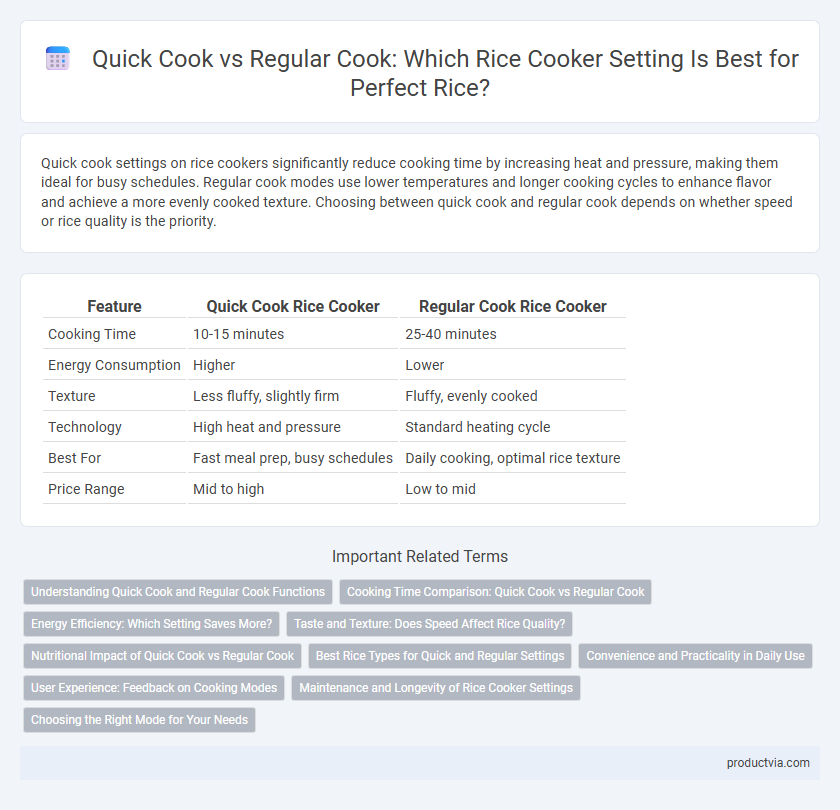Quick cook settings on rice cookers significantly reduce cooking time by increasing heat and pressure, making them ideal for busy schedules. Regular cook modes use lower temperatures and longer cooking cycles to enhance flavor and achieve a more evenly cooked texture. Choosing between quick cook and regular cook depends on whether speed or rice quality is the priority.
Table of Comparison
| Feature | Quick Cook Rice Cooker | Regular Cook Rice Cooker |
|---|---|---|
| Cooking Time | 10-15 minutes | 25-40 minutes |
| Energy Consumption | Higher | Lower |
| Texture | Less fluffy, slightly firm | Fluffy, evenly cooked |
| Technology | High heat and pressure | Standard heating cycle |
| Best For | Fast meal prep, busy schedules | Daily cooking, optimal rice texture |
| Price Range | Mid to high | Low to mid |
Understanding Quick Cook and Regular Cook Functions
The Quick Cook function in rice cookers reduces cooking time by using higher heat and pressure settings, ideal for busy schedules or when preparing small portions. Regular Cook mode prioritizes texture and flavor, allowing rice to cook evenly at a controlled temperature for traditional, fluffy results. Understanding these functions helps users select the optimal setting based on time constraints and rice type, enhancing meal quality and convenience.
Cooking Time Comparison: Quick Cook vs Regular Cook
Quick cook mode in rice cookers significantly reduces cooking time, often finishing rice in about 15-20 minutes compared to the regular cook mode, which typically takes 30-40 minutes. This faster cooking time is achieved by higher heat and pressure settings, making quick cook ideal for busy schedules or last-minute meals. However, regular cook mode usually results in better texture and flavor due to the gradual cooking process.
Energy Efficiency: Which Setting Saves More?
Quick cook settings on rice cookers typically consume more energy due to higher power usage over a shorter duration, while regular cook modes use lower power steadily over a longer time. Studies indicate regular cook settings often save energy by maintaining a consistent temperature, reducing power spikes common in quick cook cycles. Energy efficiency analyzes favor regular cooking modes, especially with larger rice quantities where gradual heat distribution optimizes power consumption.
Taste and Texture: Does Speed Affect Rice Quality?
Quick cook mode in rice cookers uses higher heat and shorter cooking times, which can result in slightly less fluffy rice with a firmer texture compared to regular cook mode. Regular cook mode allows rice to absorb water evenly at moderate heat, producing more tender grains with better flavor release and optimal moisture balance. The speed of cooking directly impacts starch gelatinization and water absorption, influencing the taste and texture quality of the final rice.
Nutritional Impact of Quick Cook vs Regular Cook
Quick cook settings in rice cookers generally reduce cooking time by using higher temperatures and pressure, which can lead to slight nutrient loss, especially of heat-sensitive vitamins like B-complex and vitamin C. Regular cook cycles, though longer, allow rice to absorb water more thoroughly, preserving more nutrients and enhancing texture and flavor. Studies indicate that while quick cooking offers convenience, regular cooking maintains higher retention of essential nutrients such as minerals and antioxidants in the rice.
Best Rice Types for Quick and Regular Settings
Short-grain and parboiled rice work best with the quick cook setting in rice cookers, as their texture softens rapidly without compromising taste. Long-grain varieties like basmati or jasmine benefit from the regular cook setting, allowing the grains to absorb water thoroughly for fluffy, separate results. Brown and wild rice require longer regular cooking cycles to achieve the desired tenderness due to their dense outer layers.
Convenience and Practicality in Daily Use
Quick cook settings in rice cookers significantly reduce cooking time by increasing heat intensity and pressure, offering unmatched convenience for busy households. Regular cook modes, while slower, ensure optimal texture and flavor by allowing rice to absorb water gradually, making them ideal for routine meal preparation. Balancing quick cook and regular cook options enhances practicality, catering to both time-sensitive moments and quality-focused daily use.
User Experience: Feedback on Cooking Modes
Users report that quick cook mode in rice cookers significantly reduces cooking time, ideal for busy schedules, but may result in slightly less fluffy rice compared to regular cook mode. Regular cook mode consistently produces evenly cooked, fluffy rice, enhancing overall taste and texture, preferred for meal quality. Feedback emphasizes quick cook as a convenient option while regular cook remains favored for optimal culinary results.
Maintenance and Longevity of Rice Cooker Settings
Quick cook settings in rice cookers use higher heat and shorter cooking times, which can cause more wear on the heating element and inner pot, potentially reducing the appliance's lifespan. Regular cook settings, operating at moderate temperatures and longer cycles, help maintain consistent heat distribution, minimizing stress on components and extending the rice cooker's durability. Proper maintenance, including cleaning the inner pot and steam vents after each use, is crucial to preserving both quick and regular cook settings' performance over time.
Choosing the Right Mode for Your Needs
Quick cook mode in rice cookers uses higher heat and shorter cooking times to prepare rice rapidly, ideal for busy schedules or last-minute meals. Regular cook mode applies a standard cooking process with balanced heat and time, producing fluffy, evenly cooked rice suited for daily meals and enhancing texture. Selecting the appropriate mode depends on whether speed or texture quality is the priority for your meal preparation.
Quick cook vs regular cook for rice cookers Infographic

 productvia.com
productvia.com